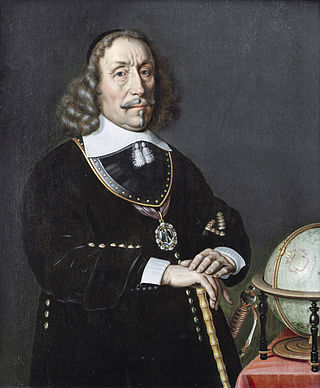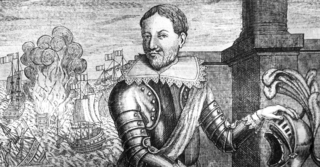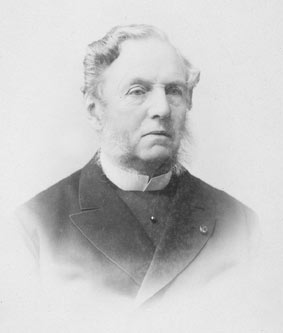Related Research Articles

The Dutch West India Company was a Dutch chartered company that was founded in 1621 and went defunct in 1792. Among its founders were Reynier Pauw, Willem Usselincx (1567–1647), and Jessé de Forest (1576–1624). On 3 June 1621, it was granted a charter for a trade monopoly in the Dutch West Indies by the Republic of the Seven United Netherlands and given jurisdiction over Dutch participation in the Atlantic slave trade, Brazil, the Caribbean, and North America.

Piet Pieterszoon Hein was a Dutch admiral and privateer for the Dutch Republic during the Eighty Years' War. Hein was the first and the last to capture a large part of a Spanish treasure fleet which transported huge amounts of gold and silver from Spanish America to Spain. The amount of silver taken was so large that it resulted in the rise of the price of silver worldwide and the near bankruptcy of Spain.

Michiel Adriaenszoon de Ruyter was a Dutch States Navy officer. His achievements with the Dutch navy during the Anglo-Dutch Wars earned him the reputation as one of the most skilled naval commanders in history.

Witte Corneliszoon de With was a Dutch States Navy officer who served during the Eighty Years' War and the First Anglo-Dutch War.

The Dutch–Portuguese War was a global armed conflict involving Dutch forces, in the form of the Dutch East India Company, the Dutch West India Company, and their allies, against the Iberian Union, and after 1640, the Portuguese Empire. Beginning in 1598, the conflict primarily involved the Dutch companies and fleet invading Portuguese colonies in the Americas, Africa, and the East Indies. The war can be thought of as an extension of the Eighty Years' War being fought in Europe at the time between Spain and the Netherlands, as Portugal was in a dynastic union with Spain after the War of the Portuguese Succession, for most of the conflict. However, the conflict had little to do with the war in Europe and served mainly as a way for the Dutch to gain an overseas empire and control trade at the cost of the Portuguese.

Cornelis Corneliszoon Jol, nicknamed Houtebeen ("pegleg"), was a 17th-century Dutch corsair and admiral in the Dutch West India Company during the Eighty Years' War between Spain and the Dutch Republic. He was one of several early buccaneers to attack Campeche, looting the settlement in 1633, and was active against the Spanish in the Spanish Main and throughout the Caribbean during the 1630s and 40s.

Dutch Ceylon was a governorate established in present-day Sri Lanka by the Dutch East India Company. Although the Dutch managed to capture most of the coastal areas in Sri Lanka, they were never able to control the Kingdom of Kandy located in the interior of the island. Dutch Ceylon existed from 1640 until 1796.

Loango-Angola is the name for the possessions of the Dutch West India Company in contemporary Angola and the Republic of the Congo. Notably, the name refers to the colony that was captured from the Portuguese between 1641 and 1648. Due to the distance between Luanda and Elmina, the capital of the Dutch Gold Coast, a separate administration for the southern districts of Africa was established at Luanda during the period of the Dutch occupation.

Jan Jacobsen was a Flemish naval commander and Dunkirker during the Eighty Years' War. He became a posthumous hero when, after battling an enemy fleet for over 13 hours, he destroyed his own ship rather than surrender.

Pieter Adriaanszoon Ita was a 17th-century Dutch privateer. He was also an admiral in the Dutch West India Company and, in 1628, commanded a large expedition against Portuguese and Spanish interests in the Caribbean. The expedition was one of the largest of its time and included many of the great privateers of the era.
Pieter Schouten was a 17th-century Dutch corsair and privateer. He was one of the first Dutchmen to explore to the Caribbean and, while employed by the Dutch West Indies Company, was involved in extensive reconnaissance to establish Dutch bases in the West Indies.
Jan Jacobsen was a mid-17th-century Flemish-born Dutch corsair and privateer. Operating out of France with other Dunkirkers such as Karel Verburg and Jan Jansen Gouverneur, he acted on behalf of England during the Second Anglo-Dutch War in the mid-1660s.

Jacques l'Hermite, sometimes also known as Jacques le Clerq, was a Flemish merchant, explorer, and admiral known for his journey around the globe with the Nassau Fleet (1623–1626) and for his blockade and raid on Callao in 1624 during that same voyage in which he also died. He served the Dutch East India Company as chief merchant in Bantam and Ambon Island in the Dutch East Indies. The Chilean Hermite Islands near Cape Horn which his fleet charted in February 1624 are named after him.

Jacob Pieter Pompejus, Baron van Zuylen van Nijevelt was a Dutch politician who served as Minister of Foreign Affairs of the Netherlands from 1852 to 1853, and again in 1861. During his second term as minister, he was also the chairman of the Council of Ministers, an office now known as Prime Minister.

Freemasonry was introduced by the Dutch to what is today Indonesia during the VOC era in the 18th century, and spread throughout the Dutch East Indies during a wave of westernisation in the 19th century. Freemasons originally only included Europeans and Indo-Europeans, but later also indigenous people with a Western education.
The Groot Desseyn was a plan devised in 1623 by the Dutch West India Company to seize the Portuguese/Spanish possessions of the Iberian Union in Africa and the Americas, in order that the Spanish would not collect enough money for their war against the Netherlands.

The siege of Zutphen was an eleven-day siege of the city of Zutphen by Dutch and English troops led by Maurice of Nassau, during the Eighty Years' War and the Anglo–Spanish War. The siege began on 19 May 1591 after a clever ruse by the besiegers. The city was then besieged for eleven days, after which the Spanish garrison surrendered.

The years 1599–1609 constituted a phase in the Eighty Years' War between the Spanish Empire and the emerging Dutch Republic. It followed the Ten Years (1588–1598) that saw significant conquests by the Dutch States Army under the leadership of stadtholders Maurice of Nassau and William Louis of Nassau-Dillenburg, and ended with the conclusion of the Twelve Years' Truce (1609–1621) on 9 April 1609. The 1599–1609 period was generally marked by a stalemate; the well-known Battle of Nieuwpoort (1600) brought the Dutch a tactical victory without long-term gain, while Spanish conquests in the Siege of Ostend (1601–1604) and Spinola's 1605–1606 campaign were effectively balanced out by the Dutch naval triumph in the Battle of Gibraltar (1607) and the Spanish state bankruptcy of the same year. Financial troubles were amongst the primary motives that prompted the Dutch, and even more so the Spanish, to head to the negotiating table for a ceasefire.

The Filips van Zuylen's campaign against Luanda took place in 1624, it was an episode of the Dutch-Portuguese War that resulted in a heavy defeat for the Dutch West India Company. After two failed attempts to conquer the city, the invading forces would retreat.
References
- ↑ Howgego, Raymond John. Encyclopedia of Exploration to 1800: A Comprehensive Reference Guide to the History and Literature of Exploration, Travel and Colonization front the Earliest Times to the Year 1800. Potts Point, NSW: Hodern House, 2003. (pg. 508) ISBN 1-875567-36-4
- ↑ Bruyneel, M. (December 28, 2007). "Piet Heyn (1577-1629)". Constitution.org. Archived from the original on July 7, 2012. Retrieved February 28, 2012.
- ↑ Postma, Johannes. Riches from Atlantic Commerce: Dutch Transatlantic Trade and Shipping, 1585-1817. Leiden, The Netherlands: Brill, 2003. (pg. 89) ISBN 90-04-12562-0
- ↑ Ratelband, Klaas, Nederlanders in West-Afrika, 1600-1650. Zutphen, 2003.